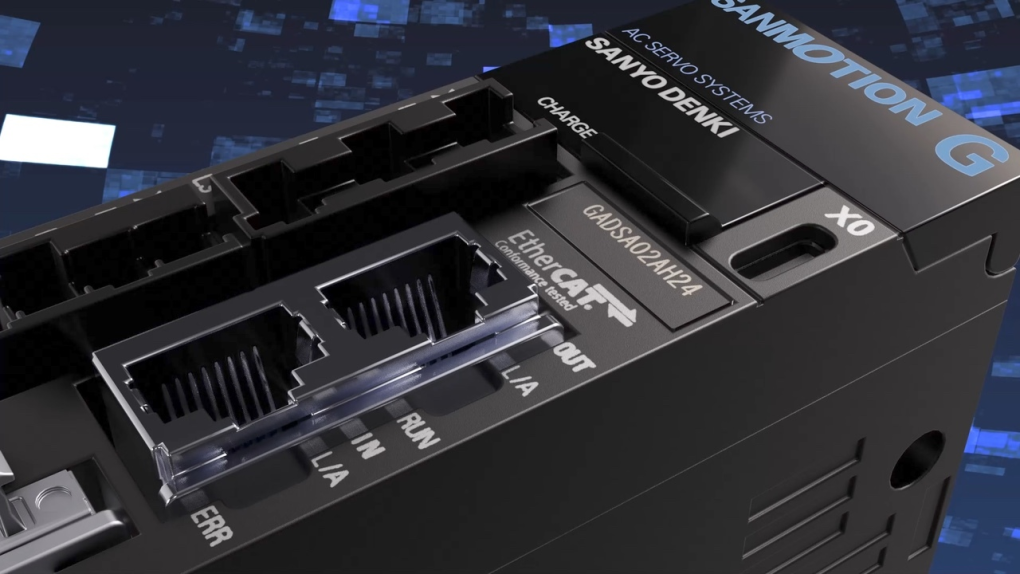Understand How Key Industrial Protocols Drive Manufacturing Efficiency within the ISA-95 Pyramid
Efficient data transfer and real-time communication are critical to modern manufacturing. SANYO DENKI leverages EtherCAT, EtherNet/IP, and OPC-UA to bridge the gap between operational control and enterprise-level decision-making, ensuring seamless automation that aligns with ISA-95 standards.
To understand how these protocols work together to optimize manufacturing, let’s explore their distinct roles across different levels of automation, as defined by the ISA-95 framework. Each protocol addresses specific needs—ranging from precise machine control to enterprise-wide data sharing—making them essential for fully integrated systems.
Why ISA-95 Matters for Automation

Automation processes can often be fragmented due to disparate systems and protocols. ISA-95 provides a standardized framework for seamless integration, ensuring that machinery, devices, and enterprise systems work in harmony. SANYO DENKI’s solutions align with ISA-95, leveraging a multi-layered communication strategy to improve productivity and reliability.
Here’s how the three key communication protocols—EtherCAT, EtherNet/IP, and OPC-UA—contribute to this integrated approach:
- EtherCAT ensures machine-level precision and synchronization. (ISA-95 Levels 0 and 1)
- EtherNet/IP connects broader systems like sensors and safety equipment. (ISA-95 Levels 1 and 2)
- OPC-UA enables strategic data sharing with enterprise systems. (ISA-95 Levels 3 and 4)
A tutorial about ISA-95 communication layers is available in our blog post, Improve Production Insights with Embedded Protocols for ISA-95 Integrated Automation.
Real-Time Precision with EtherCAT (Levels 0 and 1)

At the foundation of manufacturing operations, real-time communication is vital for controlling machinery and executing precise movements. EtherCAT is designed to meet these requirements, enabling deterministic communication between servo drives and motion controllers.
This section delves into EtherCAT’s role in SANYO DENKI’s servo systems, highlighting its importance for real-time control and synchronization at the machine level.
How It Works:
- Motion Execution: Direct communication between the SANMOTION C Motion Controller and the SANMOTION G Servo Amplifier ensures precise control over position, velocity, and torque.
- Control Coordination: EtherCAT’s distributed clock capabilities synchronize multi-axis motion, transmitting setpoints at millisecond intervals.
Practical Use Case: Motion Control with EtherCAT (ISA-95 Levels 0 and 1):
- A robotic arm with EtherCAT-enabled servo drives executes precise, synchronized movements.
- Real-time commands from the motion controller synchronize all axes via EtherCAT distributed clocks.
Broader Communication with EtherNet/IP (Levels 1 and 2)
While EtherCAT focuses on precision, manufacturing environments require broader communication to integrate peripheral devices like sensors and actuators. This is where EtherNet/IP plays a critical role, connecting systems for smoother and safer operations.
By enabling device integration and supervisory functions, EtherNet/IP complements EtherCAT, ensuring a holistic approach to automation.
How It Works:
- Device Integration: Sensors relay feedback, while actuators receive commands from the motion controller, creating a responsive manufacturing process.
- Supervisory Functions: Diagnostics and system status updates are shared with higher-level systems like SCADA, ensuring operational visibility.
Practical Use Case: Device Integration with EtherNet/IP (ISA-95 Levels 1 and 2)
- Sensors detect object positions and relay data to the motion controller via EtherNet/IP.
- A safety PLC sends emergency stop signals to the motion controller, which relays them to the EtherCAT network for immediate action.
Enterprise Connectivity with OPC UA (Levels 3 and 4)
Beyond operational efficiency, modern manufacturing demands strategic insights for decision-making. OPC-UA bridges the gap between automation systems and enterprise-level applications, transforming raw data into actionable intelligence.
This section explores how SANYO DENKI’s systems leverage OPC UA to enhance operational monitoring and enterprise integration.
How It Works:
- Operational Monitoring: Aggregated data, such as servo health and performance metrics, is shared with MES and SCADA systems for real-time analysis.
- Enterprise Integration: Data-driven insights are communicated to ERP systems, aiding production planning, maintenance scheduling, and overall business strategy.
Practical Use Case: Data Sharing with OPC-UA (ISA-95 Levels 3 and 4):
- The motion controller aggregates operational data (e.g., servo drive health and KPIs) and publishes it to an MES or SCADA system for monitoring and optimization.
- An ERP system retrieves aggregated data for production scheduling and predictive maintenance.
Why These Protocols Work Together
Manufacturing environments are complex, requiring seamless communication across various levels of automation. By integrating EtherCAT, EtherNet/IP, and OPC -UA, SANYO DENKI’s solutions address the full spectrum of manufacturing needs:
- Precision at the Machine Level: EtherCAT ensures accurate, real-time control.
- Seamless Device Communication: EtherNet/IP connects peripheral systems for broader functionality.
- Enterprise-Wide Insights: OPC UA facilitates data sharing for strategic decision-making.
Together, these protocols create a unified ecosystem that enhances productivity, reliability, and scalability in modern manufacturing.
Why SANYO DENKI
SANYO DENKI’s integrated solutions, powered by EtherCAT, EtherNet/IP, and OPC-UA, streamline manufacturing by providing precise motion control, seamless device communication, and real-time data sharing.
SANMOTION G Servo Amplifier:
Designed for high-speed, deterministic motion control. Communicates with the servo motion controller via EtherCAT for real-time operation at ISA-95 Levels 0 and 1.SANMOTION C Servo Motion Controller:
Acts as the central controller, managing motion control, device communication, and data sharing. Supports EtherCAT, EtherNet/IP, OPC-UA for integration across ISA-95 Levels, ensuring smooth coordination throughout the automation system.

Ready to optimize your manufacturing operations? Contact us today to learn more about how SANYO DENKI’s integrated automation solutions can enhance your production process.
Request A Consultation
Request a consultation for your customization needs. Our team will be in contact with you soon to provide further information and answer any questions you may have.


